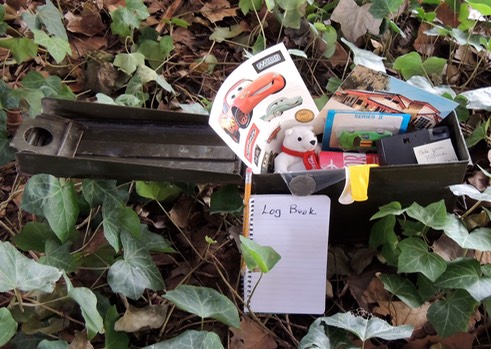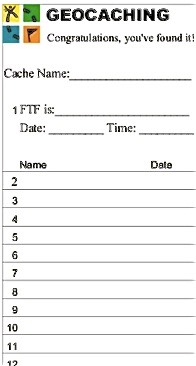Published in the La Vernia News on October 10, 2013
Try Geocaching For a Fun Day Out
Everyday Journeys
Harry and Linda Kaye Perez
Geocaching - we have heard the term many times. Our friend, Dick, who is an avid game hunter from Pennsylvania, has told us stories of his finds during downtime from hunting. But we never really understood the allure of this game - that is until now.
What is It?
Geo stands for earth and a cache is a term for something you squirrel away, perhaps to save for a later time, such as provisions on a long hike. Geocaching is an outdoor treasure hunt of sorts, where the only thing you need to participate is a hand-held GPS (global positioning system) or a GPS enabled smart phone.
Its roots go back over 150 years; letterboxing was a game that used clues and landmarks detailed in stories that led participants to a particular place. On May 3, 2000, the first geocache was placed using GPS. The coordinates were published on a website and the cache was found three days later. That event sparked a wide variety of seek and find treasure hunts.
What's The Cache?

A cache is a container filled with small “treasures.” The most popular containers are about the size of a school lunch box, usually a plastic container with a tight fitting lid. Ammunition boxes from military surplus stores have gained popularity because of its size, durability and weatherproof ability. Five-gallon buckets are used for larger caches. Inside the container will be a logbook and a pencil so that you can record your find, and small items usually not of any great monetary value, such as small toys, coins, stickers, books, or a deck of playing cards. Keep in mind that it is finding the treasure that is the most fun.
Get Started
Visit geocaching.com, one of many free geocaching websites. There you can search by zip code, view available caches in a particular area and get a list of coordinates to start your treasure hunt. The Texas Parks and Wildlife department has a great program called the Texas State Park Geocaching Challenge. It is great fun, especially for kids, but adults really get into it also.
Anywhere that has public accessibility is a great place foe a cache. The Texas State Parks are a perfect place to try your skills in geocaching. There are over two million active caches hidden all over the world. Surprisingly, the National Parks do not allow caches to be placed within the parks due to environmental concerns.
Geocaching Nearby
There are more than 300 hidden caches within a 20 mile radius of the city of La Vernia.
Some are in state parks a short drive away, such as:
.Government Canyon State - 23
.Guadalupe River State Park-20
.Palmetto State Park - 3
.Lockhart State Park - 4
Seek and Find
Visit geocaching.com and key in the ZIP code where you want to search. You can also choose based on the difficulty, size, and terrain ratings. It will give you a listing of active geocaches and their GPS coordinates. Caches will most likely be camouflaged in some way and some might be partially buried in the ground.

Once you find a cache, take note of exactly how it was placed, as you need to return it to its original location. Open the cache and using the logbook inside, log in your find using the code name that you set for yourself on one the geocaching websites. The rule is “take something, leave something of equal value.” Be sure to take a variety of items with you on your hunt. What you place in the cache is called “swag” (stuff we all get). Another rule is “leave no trace.” First, so it won’t be obvious to the next group searching for the cache, and second, to help protect the environment around the cache.
Replace the cache and soon after you return home, log into the website and report your find. The person who created the cache can monitor how many times it has been found. The simplest geocaches are referred to as drive-bys, park ‘n grabs, or cache and dash.
Spinoffs
Be careful. This can become addicting, evidenced by the variety of spin-offs of this simple game. Sometimes objects known as “hitchhikers” or “travel bugs” are moved from cache to cache and tracked by the owner to see where it goes. Another idea is leaving a disposable camera in the cache asking the finders to take a picture of themselves with the cache and then leave it for the next finder. The owner of the cache retrieves the camera when all photos have been taken and posts them online.
We think our “swag” will include cancelled postage stamps or postcards from far away places, coins we have saved from all over the world, toys from Happy Meals, playing cards from Las Vegas, and maybe even a copy of this "Everyday Journey" published in the LaVernia News!
Find Out More:
www.tpwd.state.tx.us/spdest/activities/outdoor_recreation/geocache/